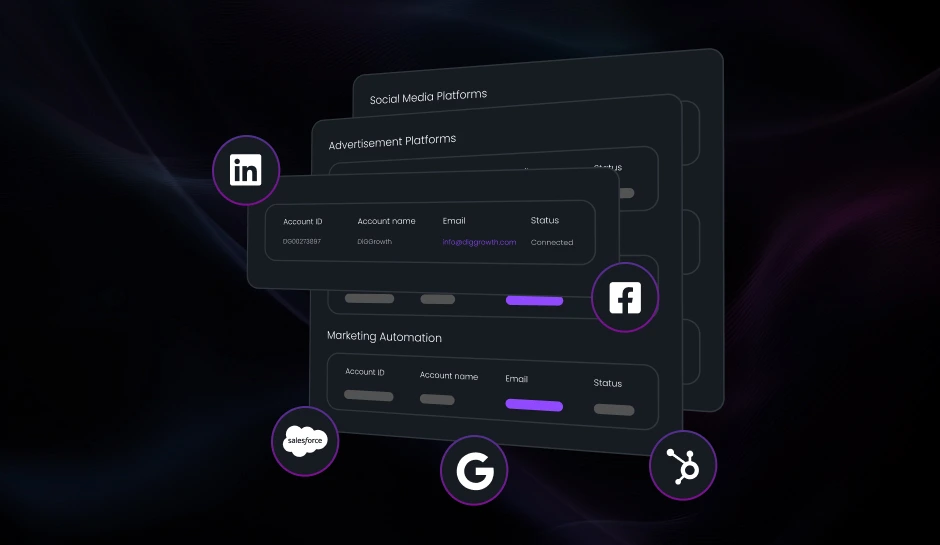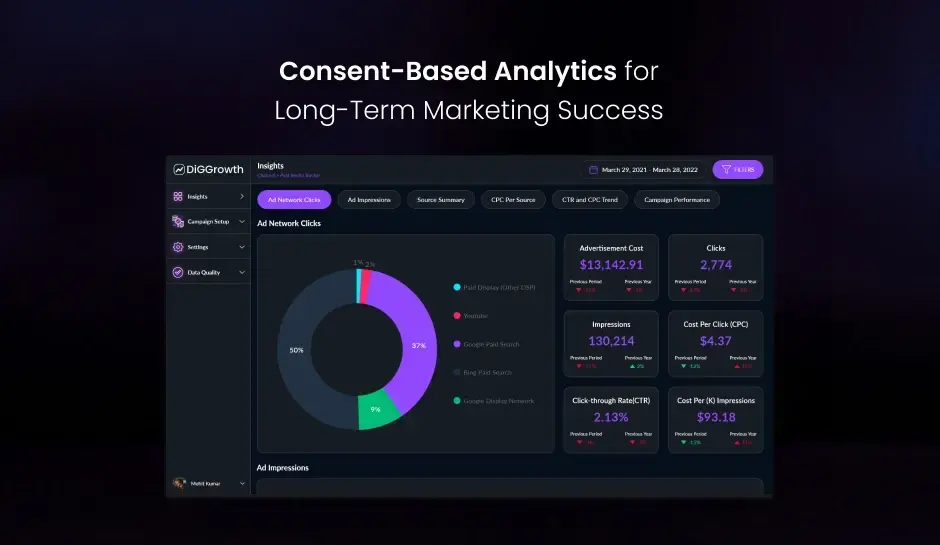
Product Analytics & Marketing Automation: Boost Campaigns
Combining product analytics with marketing automation empowers businesses to optimize their campaigns. By utilizing detailed user behavior data, companies can automate personalized marketing strategies, enhance targeting, and improve overall campaign performance. Read the blog to learn how to integrate product analytics with marketing automation to optimize your campaigns and achieve exceptional results.
Product analytics marketing automation combines user behavior insights with automated marketing strategies to create highly targeted campaigns. By integrating real-time product analytics with automation tools, businesses can personalize messaging, optimize customer journeys, and improve conversion rates. This blog explores how leveraging data-driven automation enhances marketing effectiveness and bridges the gap between customer interactions and campaign success.
A common challenge for many companies is relying solely on marketing automation without actionable insights from product analytics. Without a clear picture of user engagement, marketing campaigns are often disconnected from customers’ actual needs and behaviors. This results in poor targeting, irrelevant messaging, and lower return on investment (ROI).
The solution? Combining product analytics with marketing automation. By integrating real-time product data into your marketing strategy, businesses can tailor their campaigns based on user behavior, boosting engagement and driving better results.
What is Product Analytics?
Product analytics refers to collecting, analyzing, and interpreting data on how users interact with a product. It provides valuable insights into user behavior, feature usage, and overall engagement with a product. Businesses use these insights to make data-driven decisions, improve product functionality, and enhance user experience.
Key elements of product analytics include:
- User behavior tracking:
- Engagement metrics:
- Conversion data:
Monitoring how users navigate your product, which features they use, and where they drop off.
Understanding how often and for how long users engage with specific features or sections of your product.
Tracking the journey from user interaction to a specific goal, such as signing up, purchasing, or completing a task.
Tools like Amplitude, Mixpanel, and Pendo help businesses dive deep into product usage patterns, offering real-time insights into their products’ performance. By leveraging this data, companies can identify what’s working, where users face friction, and opportunities to optimize the product experience.
When combined with marketing automation, product analytics allows businesses to refine their messaging and deliver personalized content based on product usage, creating a seamless and more effective customer experience.
What is Marketing Automation?
Marketing automation refers to software platforms designed for organizations to market more effectively on multiple online channels and automate repetitive tasks. Encompassing a suite of tools, it orchestrates complex workflows and delivers analytical insights, ensuring that each lead can be nurtured and engaged meaningfully at scale. Sophisticated algorithms within these systems ensure the right message reaches the right user at the optimal time.
Benefits Of Automation For Marketing Campaigns
- Enhanced efficiency by automating routine tasks leads to marketing departments freeing resources for strategy and creative efforts.
- Improved lead management with lead scoring features helps businesses identify and focus on prospects most likely to convert.
- Precise targeting abilities mean messages are tailored to a specific segment of the audience based on their behaviors, preferences, and past interactions.
- Detailed analytics afford insights into campaign performance, allowing marketers to pivot and adapt strategies for better outcomes.
The Connection Between Product Analytics and Marketing Automation
Integrating product analytics with marketing automation creates a powerful synergy that enhances the effectiveness of your campaigns. You can create highly personalized and targeted marketing strategies that respond directly to user behavior by feeding product usage data into your marketing automation platform.
How Product Analytics Data Can Feed into Marketing Automation
Product analytics provides granular insights into user interactions, preferences, and behaviors. When this data is integrated into marketing automation systems, it enables you to:
- Segment audiences more precisely:
- Personalize messaging:
Use user behavior and preferences data to create detailed customer segments. For example, you can target users who frequently engage with a particular feature or those who have recently dropped off at a specific point in the user journey.
Tailor your automated communications based on real-time product usage. This ensures that users receive relevant messages about your product’s current interactions.
Examples of Automating Based on Product Insights
- Retargeting Based on User Behavior:
- Triggered Emails:
Imagine a user who has shown interest in a specific feature but has not yet completed the onboarding process. By integrating product analytics data, you can set up automated retargeting campaigns that remind the user of the benefits of that feature, encouraging them to complete the onboarding process.
If a user frequently uses a particular feature or reaches a milestone within your product, automated emails can be triggered to provide additional resources or tips related to that feature. For instance, if users regularly use a project management tool’s advanced functionalities, they could receive an automated email with best practices for maximizing those features.
Case Studies of Companies Using Product Analytics to Drive Automated Campaigns
- Spotify:
- Dropbox:
- HubSpot:
- DiGGrowth:
Spotify uses product analytics to track user listening habits and create personalized playlists. By integrating these insights with its marketing automation platform, Spotify sends users automated notifications about new playlists or features based on their listening history, resulting in higher engagement and retention.
Dropbox leverages product analytics to identify users not fully utilizing their product’s capabilities. They then use marketing automation to send personalized emails with tips and tutorials tailored to each user’s specific usage patterns, leading to increased feature adoption and customer satisfaction.
HubSpot integrates product analytics to track users’ interactions with their CRM and marketing tools. This data triggers automated workflows that deliver targeted content and support based on user activity, helping to drive engagement and improve the overall user experience.
DiGGrowth utilizes product analytics to monitor user engagement across various marketing touchpoints. DiGGrowth creates highly targeted campaigns that address specific user behaviors and needs by integrating this data with its marketing automation system. For example, suppose a user frequently interacts with certain marketing content but has not yet converted. In that case, DiGGrowth’s automated system can deliver personalized follow-ups and recommendations, enhancing conversion rates and optimizing marketing efforts.
Pro Tip- To maximize the effectiveness of integrating product analytics with marketing automation, ensure seamless data integration between your analytics and automation platforms. Utilize tools and APIs that facilitate real-time data synchronization. This lets you act on user behavior insights, enabling timely and relevant automated interactions.
Benefits of Combining Product Analytics with Marketing Automation
1. Personalization at Scale
One of the most powerful benefits of merging product analytics with marketing automation is the ability to deliver highly personalized experiences at scale. By leveraging detailed insights into user behavior and preferences, you can automate personalized messaging and content that resonates with each user. For instance, if analytics reveal that a user frequently interacts with a particular feature or shows interest in certain product aspects, you can set up automated campaigns that cater to those interests. This level of personalization enhances user engagement, fosters loyalty, and drives higher conversion rates.
2. Optimizing Product Engagement
Product analytics provides a wealth of data about how users interact with your product, including which features they use most, where they encounter difficulties, and what drives their engagement. By incorporating this data into your marketing automation strategy, you can make informed decisions about optimizing product usage. For example, suppose analytics show that users are not fully utilizing a key feature. In that case, you can create automated campaigns highlighting that feature’s benefits and providing helpful tips or tutorials. This targeted approach improves user experience and boosts overall product engagement and satisfaction.
3. Measuring Marketing Effectiveness Through Product Usage Data
Combining product analytics with marketing automation allows you to measure the effectiveness of your marketing efforts with greater precision. By tracking how users respond to automated campaigns and analyzing their subsequent product usage, you can assess the impact of your marketing strategies on user behavior. For example, you can evaluate whether an automated email campaign increases feature adoption or improves user retention. This data-driven approach enables you to continuously refine your marketing tactics, ensuring that your campaigns reach the right audience and drive meaningful results.
How to Leverage Product Analytics in Marketing Automation
To fully harness the power of product analytics in your marketing automation strategy, follow these key steps:
1. Integrate Your Analytics and Automation Platforms
Seamless integration between your product analytics tools and marketing automation platforms is crucial. Ensure data flows smoothly between the two systems to enable real-time updates and accurate insights. Many analytics platforms offer APIs and connectors that facilitate this integration.
2. Define Key Metrics and Segments
Identify the key metrics and user segments most relevant to your marketing goals. Common metrics include user engagement levels, feature usage, and conversion rates. Define segments based on these metrics, such as high-engagement users or frequently using specific features. By focusing on these segments, you can tailor your marketing automation efforts to address their needs and behaviors.
3. Create Automated Workflows Based on Product Data
Design automated workflows that leverage the insights gained from product analytics. For example:
- Onboarding Sequences:
- Retention Campaigns:
- Upsell Opportunities:
Set up automated onboarding emails for new users based on their initial interactions with your product.
Create automated reminders or offers for users who have not engaged with the product recently, encouraging them to return and use key features.
Automatically send targeted offers or recommendations based on user activity and feature usage.
4. Monitor and Adjust Your Campaigns
Use the data provided by your product analytics to monitor the performance of your automated campaigns regularly. Use this data to make informed adjustments, such as refining your messaging, updating user segments, or modifying automated workflows.
5. A/B Test and Optimize
Implement A/B testing to experiment with different automated campaign variations. Test different messaging, offers, or timing to determine what resonates best with your audience. Product analytics can help you analyze the results of these tests and make data-driven decisions to optimize your campaigns for better performance.
Key Metrics to Track for Product Analytics and Marketing Automation
Tracking the right key performance indicators (KPIs) is essential for optimizing the integration of product analytics with marketing automation. These metrics offer valuable insights that can enhance the effectiveness of your campaigns and drive better results.
Important KPIs to Monitor
- Customer Lifetime Value (CLV):
- Churn Rate:
- Feature Adoption:
- User Engagement:
- Conversion Rate:
This measures the total revenue a customer is expected to generate over their entire relationship with your company. Monitoring CLV helps identify high-value customers, allowing you to tailor automated campaigns to retain and engage these valuable users more effectively.
The churn rate indicates the percentage of customers who stop using your product within a given period. Tracking this metric helps you pinpoint the causes of customer attrition and design automated retention campaigns to address potential issues and reduce churn.
This metric tracks how often users engage with specific features of your product. By understanding feature adoption rates, you can create targeted automated campaigns that promote underused features or provide additional support for new functionalities.
Metrics like session frequency, duration, and depth provide insights into user interactions with your product. High engagement levels can guide the development of personalized content and offers in your automated campaigns, enhancing user experience and satisfaction.
This measures the percentage of users who complete a desired action, such as signing up for a trial or purchasing. Analyzing conversion rates helps evaluate the success of automated campaigns and make data-driven adjustments to improve their effectiveness.
How Tracking These Metrics Improves Automated Campaigns
- Personalization:
- Retention:
- Feature Promotion:
- Optimization:
- Segmentation:
Monitoring CLV and feature adoption allows the creation of highly personalized automated campaigns. For example, high CLV users can receive exclusive offers, while those with low feature adoption might get targeted tips to boost their engagement.
Tracking churn rate enables you to design automated campaigns to re-engage users at risk of leaving. Timely, targeted messages can help address their concerns and improve retention.
Understanding feature adoption helps to craft automated campaigns that highlight and encourage underutilized features, enhancing overall product value and user satisfaction.
User engagement and conversion rate metrics provide actionable insights into campaign performance. Analyzing these metrics allows you to refine your strategies, adjust messaging, and optimize your campaigns for better results.
Effective use of KPIs allows for precise audience segmentation, ensuring automated campaigns are tailored to different user behaviors and needs, leading to more relevant and impactful communications.
The Future of Marketing Automation and Product Analytics
As systems become more intelligent and data more accessible, marketing automation, aligned with product analytics, will be reinvented through predictive analytics and machine learning trends. These technologies are already steering businesses towards higher efficiency, enabling cascades of relevant campaigns tailored to individual user profiles and predicting future consumer needs with remarkable precision.
Machine learning algorithms hatch from today’s data to forecast tomorrow’s trends, predetermining the marketing moves companies must make to stay ahead. Rather than reacting to the current market landscape, businesses that leverage these tools can lead the way, shaping customer desires and habits. This foresight is the linchpin for sustained competitiveness in a dynamic digital economy.
Anticipating shifts in customer behavior requires an acute understanding of evolving market conditions. Marketers with data can pivot strategies swiftly, adapting to new user expectations and consumption patterns. These analytics-supported shifts aren’t simply reactions; they represent proactive measures sculpted by the insights drawn from a nexus of live data streams.
Adopting scalable, data-centric platforms is less a choice and more a necessity for all marketing operations to remain at the forefront. Such systems not only assimilate myriad data inputs but also evolve in capability as they process more information, thereby improving the precision of analytics and the effectiveness of marketing automation. The adoption of these platforms will likely determine market leadership in years to come.
Preparation for these inevitable advances hinges on present-day investment in these digital architectures. By doing so, companies will optimize their immediate marketing strategies and lay the foundation for absorbing the next wave of innovations in product analytics and marketing automation. This integration of forward-looking technologies is poised to redefine the nexus of consumer connection and product evolution.
Key Takeaways
- Product analytics marketing automation enhances campaign performance by leveraging user interaction data to optimize segmentation, personalization, and engagement.
- Automating marketing workflows improves efficiency, streamlines lead nurturing, and ensures targeted content delivery at scale.
- Integrating product analytics with automation enables precise tracking of feature adoption, user behavior, and marketing impact for data-driven optimizations.
- Key metrics like customer lifetime value, churn rate, and conversion rates provide actionable insights to refine automated campaigns and maximize ROI.
Conclusion
Integrating product analytics with marketing automation is a powerful strategy that bridges the gap between understanding user behavior and executing effective marketing campaigns. By leveraging real-time insights from product analytics, businesses can create highly personalized and targeted marketing strategies that resonate with their audience. This integration enhances campaign performance and clarifies how marketing efforts impact user engagement and product usage. Embracing this approach allows companies to refine their strategies continuously, optimize their marketing efforts, and achieve better results. Staying ahead requires a proactive approach to data integration and automation as technology advances.
Let’s transform your marketing strategy and drive exceptional results together.
For more information on enhancing your marketing campaigns through product analytics and automation integration, contact us at info@diggrowth.com and we’ll get back to you.
Ready to get started?
Increase your marketing ROI by 30% with custom dashboards & reports that present a clear picture of marketing effectiveness
Start Free Trial
Experience Premium Marketing Analytics At Budget-Friendly Pricing.

Learn how you can accurately measure return on marketing investment.
Additional Resources
Integrating Data from Different Channels for a Holistic View of Your Marketing Performance
Who's your ideal customer? Where do they come...
Read full post postGet Your Channels to Play Nice: Integrated Data for Smarter Marketing
If you’re a savvy marketer, you’re living in...
Read full post postConsent-Based Analytics: Ensure Long-Term Marketing Success
As marketers, we want our customers to perceive...
Read full post postFAQ's
Small businesses can enhance targeting, personalize campaigns, and increase ROI by leveraging detailed user insights for more effective and efficient marketing strategies.
Avoid data silos, ensure seamless integration, and guard against over-segmentation to prevent disjointed campaigns and ineffective personalization.
Data should be updated in real-time or as frequently as possible to ensure marketing automation reflects the most current user behavior and preferences.
Yes, analytics can identify common user issues and behavior patterns, allowing for more targeted and proactive customer support strategies.
Product analytics provides detailed insights into user behaviors, allowing for more precise segmentation and targeted messaging based on individual user interactions and preferences.
 Shagun Sharma
Shagun Sharma  Sameer Pawar
Sameer Pawar 

